The early career of Hollywood location manager Marc Spiegel resembles a weekly lineup of late-night Cinemax features, full of overtly sexualized thrillers with titles like Sins of Night (1993), Mirror Images II (1993), The Other Man aka Sexual Malice (1994) and A Kiss Goodnight (1994). They were low-budget and some of them non-union.
Spiegel eventually landed a few notable gigs including Hey, Hey It’s the Monkees (1997), a couple of episodes of HBO’s Tenacious D series, and the weekly TV show Sweet Valley High, on which he worked for about four years.
The teen series, produced by Saban Entertainment (of Mighty Morphin Power Rangers fame), was the largest project Spiegel had worked on up to that point, but his next job would prove the most prestigious.
The raging powerhouse drama American History X (1998) was a turning point for Spiegel, who was surprised to get the job, because it wasn’t in the category of projects he had been doing.
The film follows Edward Norton, in an Oscar-nominated performance, playing Derek Vinyard, the virulent leader of a Venice Beach Neo-Nazi skinhead gang who finds redemption and rehabilitation in prison following his murder of two Black men. Upon his release, Derek attempts to pry his impressionable younger brother Danny (Edward Furlong) from the clutches of the same vile persuasions and rhetoric that landed him in prison.
“That was the job that [afterward] I never had to look for work again,” says Spiegel. “As a matter of fact, when I was called for interviews, quite often they [producers] just wanted to sit there and talk about American History X.”
But they didn’t necessarily want to chat about the film’s locations; people were generally more interested in the infamous post-production disputes between celebrated British commercial director Tony Kaye, who was making his feature debut with American History X, and New Line Cinema.

Spiegel says Kaye, who also served as the film’s cinematographer, challenged him in ways no director had before.
“I always took it as this guy is pushing me. I can’t just put in 12 hours [a day]. I’ve gotta put in more; I’ve gotta work weekends; I’ve gotta figure out what he wants and how I can get it,” says Spiegel.
Kaye could not be reached for comment for this article.
The film’s present-day action, shot in vivid color, takes place over a 24-hour period; flashbacks that see Derek’s transition from an open-minded high-school student to a hardened and vengeful white supremacist span a handful of years and were filmed in stark black-and-white.
Spiegel says those scenes weren’t scripted in black-and-white, but he knew that Kaye was going to shoot them that way.
“I had to go out and photograph those locations in black-and-white,” says Spiegel. “This is pre-digital; I’m using a 35mm camera, and where the hell do you get a one-hour turnaround, black-and-white developing?”

American History X was shot entirely on location.
“Tony wanted to shoot the real places,” says Spiegel.
Aside from flashback prison sequences set at the California Institute for Men in Chino, the film takes place in Venice, California. But filming at geographically correct locations wasn’t always possible.
Roughly 92 minutes of the film’s nearly two-hour runtime takes place in Venice, but only half of those 92 minutes were actually filmed there.
Stylistic choices dictated the need to replicate or "double" certain locations in other areas of town.
Production concerns over gang activity centered in Venice almost made it so that none of American History X was filmed where it took place.
Militant, white supremacist skinhead groups started popping up in the Los Angeles region—largely in Orange County and even the San Fernando Valley - in the 1980s. Still, they were not a dominant presence within the L.A. punk scene, or inner city or Venice gang landscapes.
“In reality, where skinheads hang out is pretty boring and not all that visually interesting. Most of those kids come from middle-class families and middle-class neighborhoods and middle-class schools,” says Spiegel. “I think Venice was chosen purely because of its picturesque value.”
Within the context of the film, Venice never had a White gang before Derek and Cameron Alexander (Stacy Keach) - a gruff, brainwashing peddler of white power literature and videos - started recruiting frustrated and impressionable kids.
To that point, Spiegel, who now lives in Austin, Texas, remembers his days in Venice Beach and the “weird fucking mix down there.” Spiegel says, “Venice Beach would be a hot recruiting ground.”
To mark the 25th anniversary of American History X - released wide in theaters on November 20, 1998, after a limited release on October 30th - L.A. TACO returned to many of the locations of this relentlessly hard-hitting piece of ‘90s cinema.

Venice Beach
Danny, filling the void of his incarcerated brother, says that Venice was a nice, quiet place to live and grow up when his father moved the family there, but over time, gangs from Inglewood and South Central started moving west and taking over. The voice-over dialogue is heard as Kaye takes the viewers to the world-famous Venice Beach basketball courts, where games are in progress, and Danny stares down a Black classmate with whom he’s just had a confrontation in the school bathroom.



From there, we’re thrust into a flashback of Derek challenging a Black team for “ownership” of the courts in a racially motivated contest.
“It was beautifully shot. We had a crane following the action. It made basketball really look a lot more exciting,” says Spiegel, laughing.
The scene is deceiving. It was shot, edited, and musically scored in the operatic style of a sports movie, where you’re rooting on the main characters. Only in this case, the victors are Neo-Nazis who, by winning the game, are essentially telling a group of Black men to get out of their neighborhood and never come back.
Another scene shot on the periphery of the courts was a heart-to-heart conversation between Derek and Danny, in which Derek recounts his time in prison.

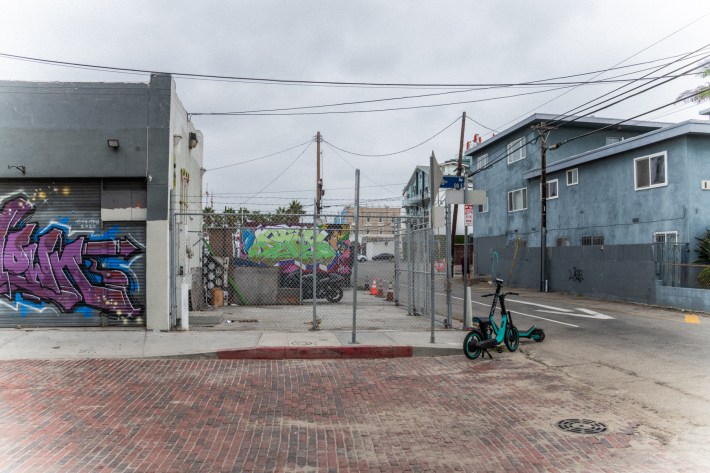


Venice Beach has a reputation for being challenging to capture on film. The impact filming has on businesses along the boardwalk means that those businesses will sometimes try to squeeze productions for a lot more money than they might lose to filming. Other businesses that aren’t affected by filming will occasionally try to get in on the action.
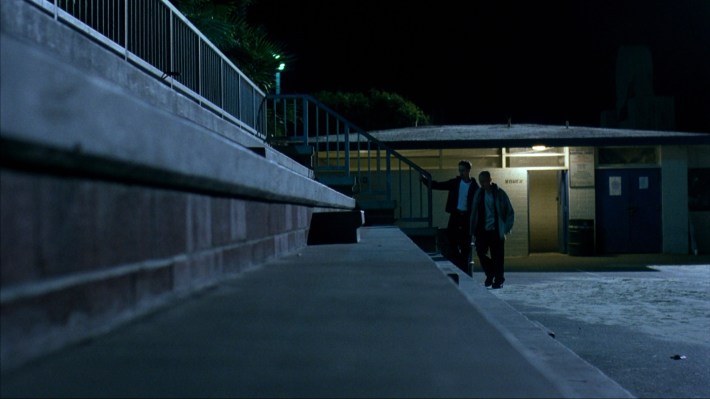

Depending on the time of year, the influx of visitors to Venice Beach can be a challenge to control.
“Venice Beach was not the problem we thought it might be,” says Spiegel. “Most of the camera work, except the basketball game, was handheld camera. So, it’s not like we had to close down and control long stretches of Venice Beach.”
However, the minimalist film-making style caused some concern while shooting a scene that didn't make the final cut, in which a homeless woman with a shopping cart is assaulted on the boardwalk by two skinhead surfers.
“A huge crowd was gathering around. And Tony is just shooting, so we don’t have a whole bunch of lighting equipment,” says Spiegel. "If you stumbled upon this, you wouldn’t automatically think this was a film. Right away, some guys ran out of the audience and tackled some of our skinhead actors, thinking that this was really fucking real.”
Venice Beach in and around the Venice Beach Basketball Courts

The Vinyard Residence
"Some legacies must end."
The film’s tagline, featured on the DVD cover, can be interpreted in any number of ways within the context of the film. But it most directly refers to the deep-rooted racism that sprouts from within a family unit.
Derek is the stereotypical all-American teenager: star athlete, straight-A student, two healthy, good-looking parents, three siblings and a nice home. From the outside looking in, it’s almost the ‘90s version of Leave it to Beaver.
Derek’s English teacher at Venice Beach High, Dr. Sweeney (Avery Brooks), whom Derek admires greatly, has the class reading Native Son, the 1940 novel by African American author Richard Wright, as part of a Black literature unit. Derek’s dad, an L.A. County firefighter, takes aim at the curriculum, convincing Derek that everything contemporary culture preaches about equal opportunity in America is highly amiss.

When Derek’s father is later shot and killed while battling a blaze at a suspected Compton drug den, Derek claims the murder to be race-related. His grief, learned prejudice and extreme intelligence combine to form a twisted worldview that he is able to articulate to a group of equally frustrated disciples clearly.
Spiegel says of the Vinyard house, “I knew I wanted a Craftsman or something like that. They wouldn’t be living in one of those contemporary houses that were sprouting up all over Venice. The guy is a fireman, so he’s made good money. It had to be a nice house, but not overly expensive. And Craftsman are kind of what the area of Venice certainly was.”


Arguably the most harrowing scene in the film takes place outside the Vinyard house at night and involves the aforementioned murders.
Derek shoots and kills one man standing guard outside the house’s front door. The other man, who was on the losing basketball team on the Venice basketball courts, is shot in the leg while breaking into Derek’s car. Wounded on the ground, he is subsequently forced, at gunpoint, to open his mouth and put his teeth on the curb. Derek, with all his pent-up anger, stomps on the back of the man’s head, crushing his skull against the cement. The cops arrive on scene and arrest Derek.


Spiegel found suitable Craftsman homes all over town.
“A house is a house is a house. You tell the audience it’s in Venice Beach, it’s in Venice Beach. I can find the same house in North Hollywood or anywhere. You don’t really see beyond the house,” says Spiegel. “It didn’t have to be in the danger area where I couldn’t get a permit.”
In the mid-‘90s, a raging gang war between the Venice Shoreline Crips and Venice 13 was taking place in the Oakwood neighborhood only a few blocks away from the location that Kaye gravitated towards - a 1907 Craftsman with an asymmetrical facade, which lends an off-kilter aesthetic that speaks to the turmoil lying within its walls. Other gang disputes continued in the area around the time of filming.
Spiegel remembers that after the house was settled upon, the L.A. film office wanted to cancel the shooting permit at the location, which is located just off Venice Boulevard west of Lincoln Boulevard.
“When we announced that there was going to be shooting and noise and nighttime filming and police sirens, and we wanted a helicopter, everything that sparks even more gang violence, they wanted to yank our permit for our own safety,” says Spiegel. (The helicopter searchlight effect was replicated from a crane, as the city wouldn’t allow the production to fly a helicopter at a low enough altitude.)
As a workaround, Spiegel brokered a meeting with his head of security, a pastor who was affiliated with the First Lutheran Church, located across the street from the Vinyard house, and heads of the local gangs. A plan was put in place that involved hiring gang members to work security around the perimeter of the house, a proposal the police were not thrilled with, Spiegel recalls.
The filming permit was eventually re-issued.
“We sort of had three lines of defense. We had the gang members out on the perimeter keeping people away, we had the cops a little closer to the set, and then I had my security that was basically escorting actors and watching the equipment,” says Spiegel.
He adds, “If somebody who wasn’t supposed to be there would start cruising by, the gang members on the perimeter would just point at the car with their finger and then just shoe the car away. A cop couldn’t do that.”
2206 Meade Place Venice

Venice Beach High
Danny, like his brother before him, attends Venice Beach High. Dr. Sweeney, who is now the school principal, summons Danny to his office after he turns in a history paper entitled My Mein Kampf. Sweeney, who supported Derek’s prison rehabilitation, assigns Danny to write a new paper about his brother as part of a one-on-one class called American History X.
“Tony wanted Venice High School. It couldn’t have been another high school,” says Spiegel. “It was pretty much ordained it was going to be Venice.”

Spiegel knew securing Venice High School wouldn’t be a problem, as it was known for being film-friendly. Grease (1978) is the most popular film to have used the campus - one of three L.A.-area schools that made up Rydell High.
Still, Spiegel had a couple of backups in the off-chance that Venice High School didn’t work out.
He submitted Hamilton High School in the neighborhood of Castle Heights, which he used for Sweet Valley High, and Grant High School in the Valley.




While filming wasn’t an issue at Venice High School, a conflict arose over the school's name.
“L.A. Unified School District [had] a policy in which you cannot use the real name of the school you’re shooting at,” says Spiegel. “Tony was insistent that this is a story is about Venice, and this is Venice High School.”
A compromise was struck.
“We changed the signs to Venice Beach High School,” says Spiegel.
The current LAUSD filming application suggests that productions may be able to use school names, but those requests are subject to extra processing time, fees, releases, and legalities.
Filming took place outside the school’s main entrance along Venice Boulevard and inside the administration building's front office and ground-floor hallway.
The film’s heart-stopping conclusion sees Danny shot in the school bathroom. The devastating high-speed/slow-motion image shows Danny knocked off his feet as he is pierced by three rounds; blood explodes from his chest and spatters against the porcelain urinals and tiled wall behind him.


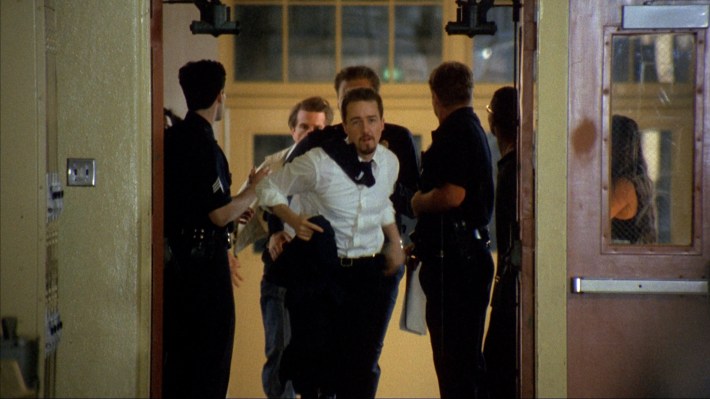

The distressing scene was filmed inside a gym bathroom. Spiegel says it was shot three separate times over a period of a few months in order to refine the blood spatter effect.
“I bet you if you go to the boys' bathroom in the gym, you’ll still see the blood on the ceiling. We could never get it off. Years later, it was up there,” says Spiegel.
The school’s plant manager informed L.A. TACO that the old gym was demolished a little over a year ago as part of a modernization project of the school campus, which saw the construction of a new gym facility adjacent to the site of the old gym.
13000 Venice Blvd. Venice

LAPD Pacific Station
The LAPD Pacific Division serves the neighborhoods of Venice, Del Rey, Manchester Square, Mar Vista, Oakwood, Palms, Playa del Rey, Playa Vista, and Westchester.
Located on Culver Boulevard, just east of Centinela Avenue, the brown brick and concrete-built Pacific Station was not visually exciting for cinematic purposes, says Spiegel.
He adds, “Tony wanted something more high-tech than not [for the police station], where all the other locations were more low-key.”


Spiegel didn’t look in downtown L.A. because, at the time, nothing felt particularly modern.
“Everything in Downtown was just crumbling red brick buildings that looked like great New York police stations,” says Spiegel.

He eventually pushed his search all the way to Malibu, where he found a futuristic, two-story glass office building that was home to an architectural firm.
Built in 1986, the blocky, translucent structure was designed by notable Modernist architect Ed Niles, who built a number of homes and office buildings in the affluent beach community, including the circular Point Dume Plaza, which is located across the parking lot from the police station location.
In the film, the Santa Monica Mountains and a sign for a Malibu cycling shop can be glimpsed in the background as Dr. Sweeney pulls up to the building.
29178 Heathercliff Rd. Malibu
Vinyard Apartment


Sometime during Derek’s incarceration, his mother, Doris, (Beverly D’Angelo), and three siblings move from their Craftsman home into a run-down and weathered two-bedroom Venice apartment. The situation is dire. Doris sleeps on the couch so that her children can have the bedrooms; she’s a chain smoker who’s constantly hacking at all hours of the day and night.
Spiegel’s assistant submitted a two-floor Hollywood apartment building for the location.
“I didn’t like it at first,” says Spiegel. “For some reason, it didn’t feel like Venice to me. But on the other hand, going inland away from Venice Beach, going down Venice Boulevard and then off to the side streets, there are some unkempt looking apartments.”
One of the building’s ground-floor units happened to be unoccupied.
“That was lucky, and we were paying the landlord six times the monthly rent,” says Spiegel.
The art department initially recommended building a set for the tight apartment interior.
“Nothing in that place was big,” he adds, but again, Kaye wanted the real thing. “The way Tony shot it, it worked. He really knew what he was doing when it came to the images."
The art department had the location for a couple of weeks to prep.
“They literally painted the walls with water and tobacco for tobacco stains because of how much [Doris] smoked,” says Spiegel.
1250 Gordon St. Hollywood

Archie’s Ranch Market
Derek’s indoctrination tactics are on full display when he assembles members of his gang in the parking lot of a privately-owned Venice supermarket. Making a case to his followers, Derek says that the grocery store had been a part of the community since he was a kid. When the business went under it was bought by a Korean family that fired Derek’s friends and replaced them with “border jumpers.” Charged with fury, Derek’s masked gang storms the grocery store, ransacking shelves and assaulting employees.
“It was really hard to find a store that’s, first of all, big enough that it can be rampaged - it can’t be a little corner store - and that they’re going to let you fucking wreck shit,” says Spiegel. “I realized right away I’m not looking at a corporate store. I’ve got to find a big, private grocery store.”
Spiegel says he narrowed down the search to the Valley because the inner city didn’t have many stores that fit his requirements.

A number of markets passed on the opportunity when they learned what the production wanted to do inside, but Archie’s Ranch Market on Lankershim Boulevard in North Hollywood had done some filming before and was familiar enough with the process that they agreed.

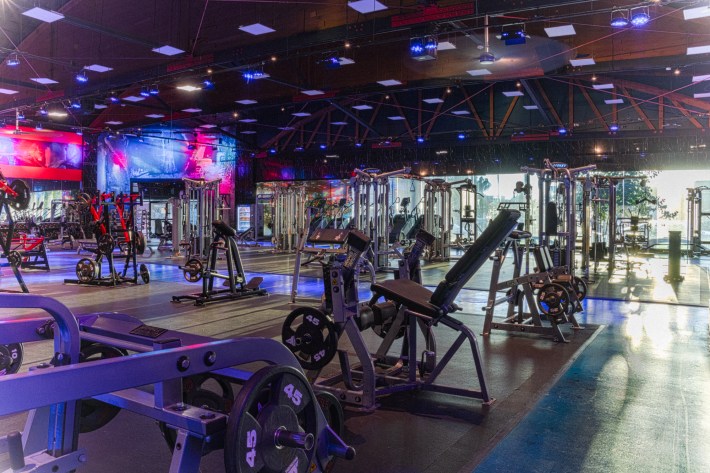
The script was tailored to the location; Derek directly references Archie Miller as the original owner. (The owner at the time of filming was not Archie).
The production made a deal with the store to buy all the products on certain shelves so that it could be destroyed.
Spiegel says that the rampage was choreographed, but when overhead light fixtures were unexpectedly smashed, glass was sent flying into the produce section.
“Now we’re buying all the produce,” says Spiegel, who arranged to get the owner another $5,000 on top of the initial $5,000 deposit for any repairs that needed to be done after the production left.
Newspaper clippings advertise Archie’s Ranch Market, operating since the mid-‘60s.
As of 2011, Google Street View shows the location still being run as Archie’s, but by the summer of 2014, the store’s signage was no longer on the building.
In 2017, the location opened as USA Fitness. During COVID closures, the company rebranded as Speakeasy Fitness when they moved operations to the parking lot due to city mandates that allowed for the operation of outdoor gyms. They kept the name when they moved back inside.
7500 Lankershim Blvd. North Hollywood

Cameron’s Compound
On the night of Derek’s prison release, a considerable skinhead blowout is set to take place at Cameron’s place, which is said, early in the film, to be near the beach.
The location, however, was nowhere near Venice.
Originally, Spiegel pitched an abandoned foundry in the Cypress Park area. He says that the art department liked it enough to draw renderings of Nazi flags on tracing paper over his location scout photos. He was surprised when the location wasn’t chosen.
From that point on, Spiegel had a hard time pinpointing a sufficient location.

He eventually found what he says was an abandoned train engineering building across from a Fedco department store. Upon watching the film, you can briefly see the Van Nuys Fedco store sign in the background. The store closed in 1999 and is today a Target.
Spiegel remembers thinking that the reverse angle at the location wasn’t great because of the Fedco. But that was one reason Kaye liked it.
“Tony goes, ‘I want people to know that skinheads live among them,’” says Spiegel.
A visit to the area shows that a number of the industrial buildings along the stretch of Raymer Street, where the compound was filmed, have been replaced with newer warehouse properties.
14901 Raymer St. Van Nuys (approximate address)

‘Chino’
After the murders at the Vinyard house, Derek is convicted of voluntary manslaughter. When taking into account that Derek serves just over three years in prison, the flashback sequences start about one to two years after the Rodney King beating.
Even though Danny says that Derek would have served life if he had testified against his older brother, the paltry prison sentence comes across as a subtle rebuke of the American justice system.
When Derek spies a member of the Aryan Brotherhood doing favors for a Latino inmate - a double standard in Derek’s mind - his purist ideations are called into question. After making his displeasure known, Derek is raped by a muscle-bound member of his own prison gang.
As Derek works amicably alongside a Black inmate in the prison laundry facility, and Sweeney offers his support, he finds himself examining everything that has led up to his incarceration.
Chino was comprised of various jail facilities around L.A. County to achieve the effect of a single-operating prison flexibly.
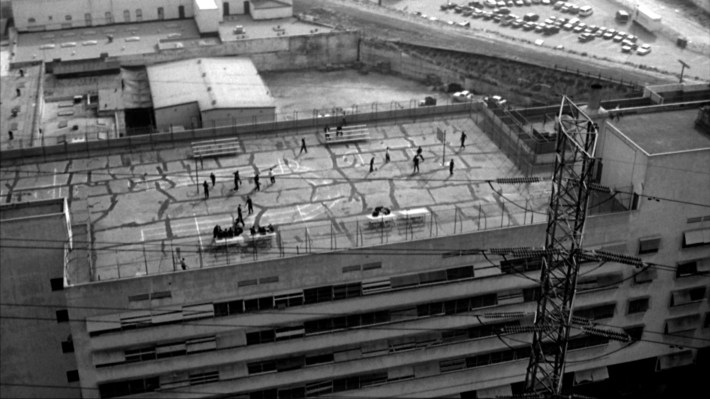

Unmistakable is the rooftop of Lincoln Heights Jail.
The infamous L.A. jail was of concern for the location manager, who was trying to match the flat topography of Chino.
“I was worried that the rooftop of the Lincoln Heights Jail really looks like L.A.,” says Spiegel. “We probably ended up at Lincoln Heights because there was so much you could do there."
Cellblock and shower scenes were also filmed at Lincoln Heights.
Spiegel says that a phone visitation scene between Derek and Doris was shot at the Sybil Brand Institute, the L.A. County women’s prison in City Terrace that closed in 1997 and became a frequently used filming location.
Neither Lincoln Heights nor Sybil Brand afforded the filmmakers the aesthetics to shoot exteriors indicative of the men’s prison in Chino. Instead, the recreational yard, Sally Port gate, and cafeteria were filmed at Pitchess Detention Center, off the 5 freeway in Castaic.
421 N Ave 19 Lincoln Heights; 4500 City Terrace Dr. City Terrace; 29340 The Old Rd. Castaic

Johnie’s Coffee Shop
Before Danny turns in his new essay to Dr. Sweeney, Derek walks his brother to school. They stop at Johnie’s Coffee Shop, the classic Mid-Wilshire, Googie-style diner that’s been closed since 2000 and is also featured in ‘90s fan favorites like Reservoir Dogs (1992) and The Big Lebowski (1998).
Derek is constantly looking over his shoulder, expecting retaliation after having just assaulted Cameron at the previous night’s party.
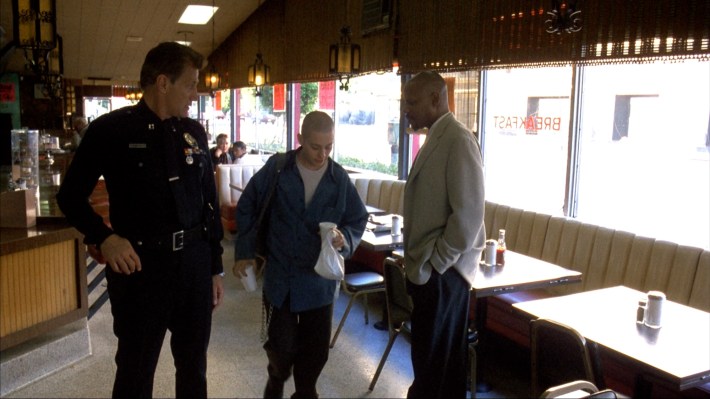


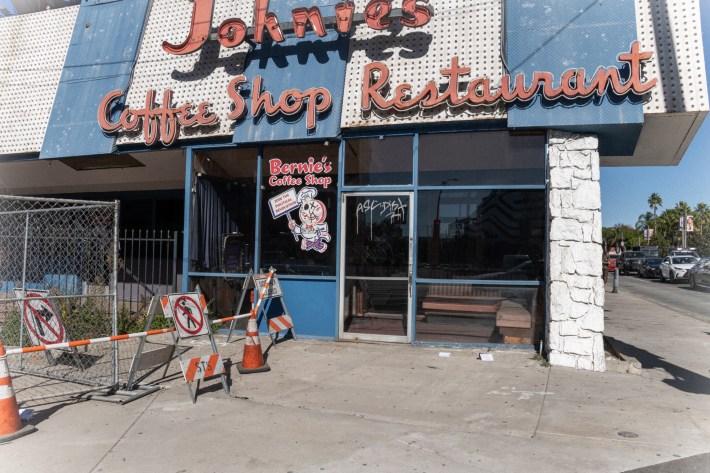
Johnie’s Coffee Shop. Photo by Jared Cowan for L.A. TACO.
“I had various, somewhat similar looking restaurants as options,” says Spiegel, “but Johnie’s kind of sold itself.”
Being that Danny and Derek arrive and depart Johnie’s on foot before heading to Venice Beach High, we’re led to believe that Johnie’s, like most of the settings in American History X, is in Venice.
6099 Wilshire Blvd. Mid-Wilshire
Some of these locations are on private property. Please do not trespass or disturb the owners.







